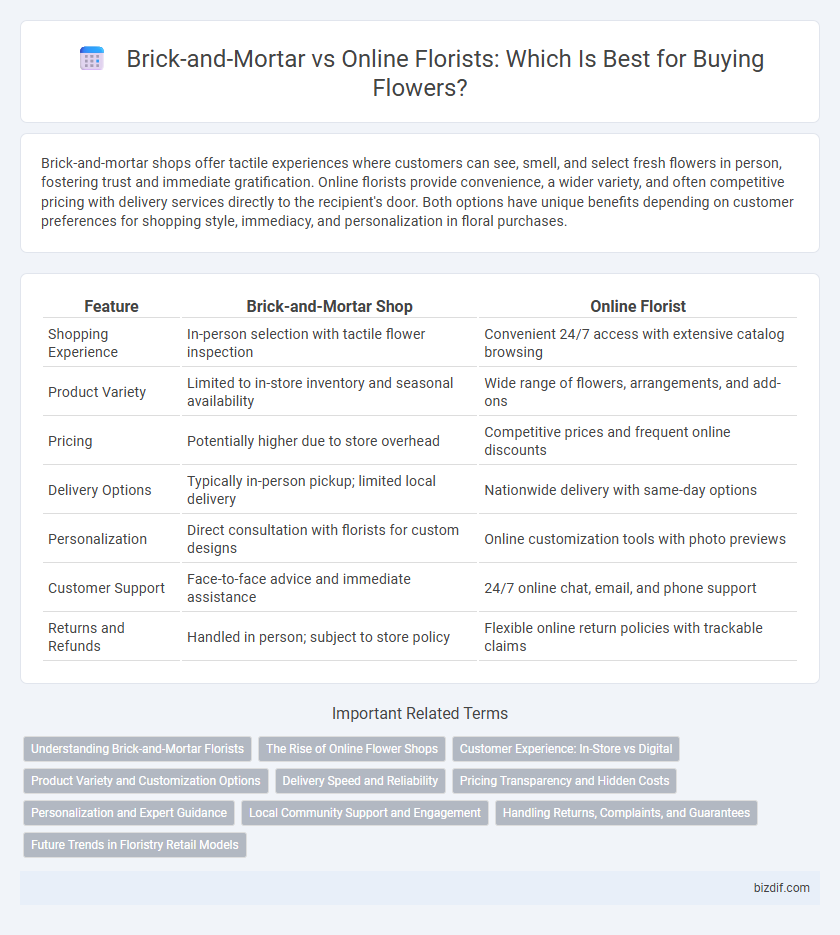Brick-and-mortar shops offer tactile experiences where customers can see, smell, and select fresh flowers in person, fostering trust and immediate gratification. Online florists provide convenience, a wider variety, and often competitive pricing with delivery services directly to the recipient's door. Both options have unique benefits depending on customer preferences for shopping style, immediacy, and personalization in floral purchases.
Table of Comparison
| Feature | Brick-and-Mortar Shop | Online Florist |
|---|---|---|
| Shopping Experience | In-person selection with tactile flower inspection | Convenient 24/7 access with extensive catalog browsing |
| Product Variety | Limited to in-store inventory and seasonal availability | Wide range of flowers, arrangements, and add-ons |
| Pricing | Potentially higher due to store overhead | Competitive prices and frequent online discounts |
| Delivery Options | Typically in-person pickup; limited local delivery | Nationwide delivery with same-day options |
| Personalization | Direct consultation with florists for custom designs | Online customization tools with photo previews |
| Customer Support | Face-to-face advice and immediate assistance | 24/7 online chat, email, and phone support |
| Returns and Refunds | Handled in person; subject to store policy | Flexible online return policies with trackable claims |
Understanding Brick-and-Mortar Florists
Brick-and-mortar florists offer personalized flower arrangements crafted with local, fresh blooms that online retailers often cannot guarantee. These shops provide customers with immediate product inspection, in-person consultation, and same-day pickup or delivery, enhancing trust and satisfaction. Physical floral stores also support local economies and foster community relationships through customized services and expert advice.
The Rise of Online Flower Shops
Online flower shops have surged in popularity due to their convenience, extensive selection, and ability to deliver fresh blooms directly to customers' doors. E-commerce platforms leverage real-time inventory management and personalized customer experiences, resulting in faster order processing and wider geographic reach compared to traditional brick-and-mortar florists. Market trends indicate that online florists capture an increasing share of the floral industry's revenue, driven by mobile app integration and seamless payment options.
Customer Experience: In-Store vs Digital
In-store floristry offers a tactile customer experience where clients can personally select blooms and receive immediate expert advice, enhancing satisfaction through sensory engagement. Online florists provide convenience with 24/7 access, detailed flower descriptions, and customizable delivery options, catering to busy lifestyles and distance shopping. Both platforms leverage unique customer touchpoints, with brick-and-mortar shops emphasizing physical interaction and online services focusing on digital ease and personalization.
Product Variety and Customization Options
Brick-and-mortar florists often provide a tactile experience with fresh flowers and personalized customization through in-store consultations, allowing customers to select specific blooms and arrangements directly. Online florists, however, typically offer a broader product variety due to extensive supplier networks and digital customization tools such as virtual bouquet designers and add-on options like vases or chocolates. Consumers seeking highly tailored floral designs benefit from physical shops, while those prioritizing diverse choices and convenience lean toward online floral services.
Delivery Speed and Reliability
Brick-and-mortar florists typically offer faster delivery for local orders due to their proximity and ability to handpick fresh flowers, ensuring superior reliability and quality upon arrival. Online florists provide wider delivery coverage but often depend on third-party couriers, which can introduce delays and variability in freshness. Choosing a local physical shop enhances delivery speed and guarantees fresher bouquets, while online services excel in availability but may face logistical challenges.
Pricing Transparency and Hidden Costs
Brick-and-mortar flower shops often present clearer pricing with upfront costs, allowing customers to see actual bouquet arrangements and avoid surprises. Online florists may list lower base prices but frequently include hidden costs such as delivery fees, service charges, and surcharges for customization. Transparent pricing is essential in comparing total expenses between physical stores and digital platforms to ensure budget accuracy in floral purchases.
Personalization and Expert Guidance
Brick-and-mortar florists offer personalized consultations and expert guidance, allowing customers to select flowers tailored to specific occasions and preferences through face-to-face interaction. Physical shops provide hands-on experience with floral arrangements, ensuring quality and customized designs crafted by skilled florists. Online florists rely on digital customization tools but often lack the nuanced expertise and immediate feedback available in-store, which can impact personalization and customer satisfaction.
Local Community Support and Engagement
Brick-and-mortar florists foster stronger local community support by offering personalized service and engaging directly with customers through in-store events and workshops. These physical shops often source flowers from local growers, stimulating the regional economy and promoting sustainable practices. In contrast, online florists provide convenience but may lack the tangible community connections and immediate support that brick-and-mortar stores cultivate within neighborhoods.
Handling Returns, Complaints, and Guarantees
Brick-and-mortar florists offer personalized in-store support for handling returns and complaints, enabling immediate resolution and product exchanges. Online florists provide digital customer service channels with policies often including satisfaction guarantees and refund options to manage issues remotely. Clear communication and flexible return policies enhance trust and customer satisfaction in both sales environments.
Future Trends in Floristry Retail Models
Future trends in floristry retail models emphasize the integration of augmented reality (AR) to enhance customer experiences in both brick-and-mortar shops and online florists. Sustainability-driven practices and AI-powered personalized floral recommendations will increasingly shape consumer preferences, promoting eco-friendly sourcing and tailored arrangements. Hybrid models combining physical storefronts with robust e-commerce platforms are expected to dominate, offering seamless omnichannel purchasing and real-time inventory updates.
Brick-and-Mortar Shop vs Online Florist Infographic

 bizdif.com
bizdif.com